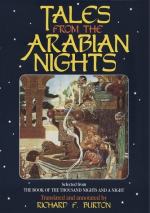[FN#65] Arab. “Jauz al-Hindi”: our word cocoa is from the Port. “Coco,” meaning a “bug” (bugbear) in allusion to its caricature of the human face, hair, eyes and mouth. I may here note that a cocoa-tree is easily climbed with a bit of rope or a handkerchief.
[FN#66] Tomb-pictures in Egypt show tame monkeys gathering fruits and Grossier (Description of China, quoted by Hole and Lane) mentions a similar mode of harvesting tea by irritating the monkeys of the Middle Kingdom.
[FN#67] Bresl. Edit. Cloves and cinnamon in those days grew in widely distant places.
[FN#68] In pepper-plantations it is usual to set bananas (Musa Paradisiaca) for shading the young shrubs which bear bunches like ivy-fruit, not pods.
[FN#69] The Bresl. Edit. has “Al-Ma’arat.” Langles calls it the Island of Al-Kamari. See Lane, iii. 86.
[FN#70] Insula, pro. peninsula. “Comorin” is a corrupt. of “Kanya” (=Virgo, the goddess Durga) and “Kumari” (a maid, a princess); from a temple of Shiva’s wife: hence Ptolemy’s {Greek letters} and near it to the N. East {Greek letters}, “Promontorium Cori quod Comorini caput insulae vocant,” says Maffaeus (Hist. Indic. i. p. 16). In the text “Al’ud” refers to the eagle-wood (Aloekylon Agallochum) so called because spotted like the bird’s plume. That of Champa (Cochin-China, mentioned in Camoens, The Lus. x. 129) is still famous.
[FN#71] Arab. “Birkat"=tank, pool, reach, bight. Hence Birkat Far’aun in the Suez Gulf. (Pilgrimage i. 297.)
[FN#72] Probably Cape Comorin; to judge from the river, but the text names Sarandib (Ceylon Island) famous for gems. This was noticed by Marco Polo, iii. cap. 19; and ancient authors relate the same of “Taprobane.”
[FN#73] I need hardly trouble the reader with a note on pearl-fisheries: the descriptions of travellers are continuous from the days of Pliny (ix. 35), Solinus (cap. 56) and Marco Polo (iii. 23). Maximilian of Transylvania, in his narrative of Magellan’s voyage (Novus Orbis, p. 532) says that the Celebes produce pearls big as turtle-doves’ eggs; and the King of Porne (Borneo) had two unions as great as goose’s eggs. Pigafetta (in Purchas) reduces this to hen’s eggs and Sir Thomas Herbert to dove’s eggs.
[FN#74] Arab. “Anbar” pronounced “Ambar;” wherein I would derive “Ambrosia.” Ambergris was long supposed to be a fossil, a vegetable which grew upon the sea-bottom or rose in springs; or a “substance produced in the water like naphtha or bitumen"(!): now it is known to be the egesta of a whale. It is found in lumps weighing several pounds upon the Zanzibar Coast and is sold at a high price, being held a potent aphrodisiac. A small hollow is drilled in the bottom of the cup and the coffee is poured upon the bit of ambergris it contains; when the oleaginous matter shows in dots amidst the “Kaymagh” (coffee-cream), the bubbly froth which floats upon the surface and which an expert “coffee servant” distributes equally among the guests. Argensola mentions in Ceylon, “springs of liquid bitumen thicker than our oil and some of pure balsam.”




